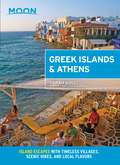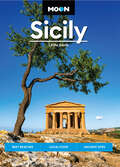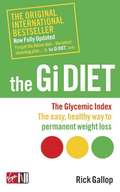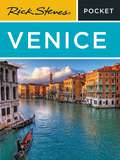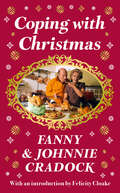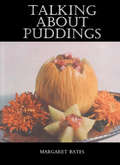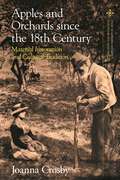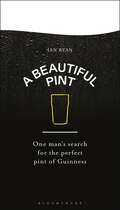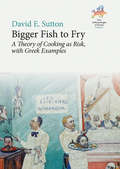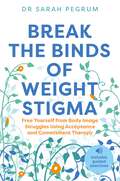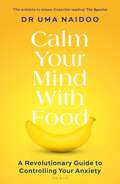- Table View
- List View
Moon Greek Islands & Athens: Island Escapes with Timeless Villages, Scenic Hikes, and Local Flavors (Travel Guide)
by Moon Travel Guides Sarah SouliSoak up the sun, dance till dawn, hike through wild forests, or explore Greek history: Escape to the Mediterranean with Moon Greek Islands & Athens. Choose the right islands for you, with strategic itineraries for different timelines, budgets, and activities, whether you want to lounge on the best beaches, linger in ancient villages, explore the outdoors, or island-hop for a little taste of everythingFocused coverage of Athens and 18 Greek islands, including Santorini, Mykonos, Karpathos, Corfu, Lefkada, and moreUnique experiences and must-see highlights: Marvel at Oia's picturesque blue and white architecture or take a boat to the birthplace of Apollo and Artemis. Soak in therapeutic hot springs, hike through lush forests to waterfalls in Samothrace, or hop aboard a boat and discover hidden coves and wild beaches. Learn about local folklore in Olympos, explore Athens' contemporary galleries and ancient ruins, and savor authentic Greek cuisine, from roasted lamb and olives to dakos and fiery shots of ouzo Insight from Athens local Sarah Souli on how to experience Greece like an insider, support local businesses, and avoid over-tourismFull-color photos and detailed maps throughoutBackground information on the landscape, history, and cultural customs of Greece and each individual islandHandy tools and practical necessities like advice on getting there and getting around, and tips for solo women travelers, seniors, visitors with disabilities, LGBTQ+ travelers, and families with kidsIn-depth coverage of: Athens, Santorini, Mykonos, Folegandros, Milos, Naxos, Anafi, Karpathos, Rhodes, Kalymnos, Samothrace, Ikaria, Lesvos, Alonnisos, Skyros, Corfu, Zakynthos, Lefkada, and CreteWith Moon's practical tips and local know-how, you can experience the best of Athens and the Greek islands.Exploring more of Europe? Check out Moon Rome, Florence & Venice, Moon Prague, Vienna, & Budapest, or Moon French Riviera.
Moon Sicily: Best Beaches, Local Food, Ancient Sites (Travel Guide)
by Linda Sarris Moon Travel GuidesFrom relaxing on sun-soaked beaches to hiking Mount Etna, immerse yourself in la dolce vita with Moon Sicily. Inside you'll find:Flexible itineraries for exploring the best of Sicily, including Palermo, Western Sicily, the Aeolian Islands, Catania, Mount Etna, Syracuse, and more Strategic advice for foodies and oenophiles, art lovers, hikers, history buffs, beach bums, and more Must-see highlights and unique experiences for any season: Go climbing and wine-tasting on scenic Mount Etna. Visit the noble palaces and flourishing outdoor markets of Palermo. Island-hop and soak up the spectacular beaches of the Aegadian Islands. Walk among Greek ruins at the Valle dei Templi and wander romantic towns like Cefalú and Taormina The best local flavors: Savor fresh seafood straight from the Mediterranean, sample locally made sheep cheese, and taste some of Italy&’s best street food in Palermo. Enjoy diverse Sicilian wines like historic marsala and sip a morning cappuccino at a charming café Expert advice from Palermo local and chef Linda Sarris on where to stay, what to eat, and how to get around Full-color photos and detailed maps throughoutBackground information on the landscape, history, and cultural customs Handy tools including an Italian phrasebook and tips for senior travelers, travelers of color, traveling with children, and more With Moon&’s practical tips and local insight on the best things to do and see, you can experience the very best of Sicily. Exploring more of Italy? Check out Moon Southern Italy or Moon Rome, Florence & Venice.About Moon Travel Guides: Moon was founded in 1973 to empower independent, active, and conscious travel. We prioritize local businesses, outdoor recreation, and traveling strategically and sustainably. Moon Travel Guides are written by local, expert authors with great stories to tell—and they can't wait to share their favorite places with you. For more inspiration, follow @moonguides on social media.
The Gi Diet (Now Fully Updated): The Glycemic Index; The Easy, Healthy Way to Permanent Weight Loss
by Rick GallopThe Original International Gi Diet Bestseller, Now Revised And Updated- Over 40 all new recipes and meal plans- Over 100 new red, yellow and green light food listings- Updates on everything from low carbs to office lunches and family meals- More readers' comments and suggestionsMost diets fail for these three reasons - you go hungry, they're too complicated or they are simply unhealthy. With Rick Gallop's acclaimed Gi diet- you won't feel hungry or deprived- you will never have to count calories, carbs or points again- it's healthy and nutritious and will reduce your risk of major diseases.Based on the Glycemic Index, or GI, which rates foods according to how fast they are digested, the Gi Diet makes choosing the right food simple with its unique, easy-to-follow traffic light system:*Foods to avoid*Foods to eat occasionally*Foods to eat as much of as you wantAnd the benefits are more than just weight loss! Changing your eating habits can also help prevent life-threatening illnesses, like heart disease and diabetes."Losing weight is relatively easy with many "fad" Diets; maintaining the loss with these diets is difficult and largely impossible to sustain. Rick Gallop has found the key to permanent weight loss"
Rick Steves Pocket Venice
by Rick Steves Gene OpenshawMake the most of every day and every dollar with Rick Steves! This colorful, compact guidebook is perfect for spending a week or less in Venice:City walks and tours: Eight detailed tours and walks showcase Venice's essential sights, including St. Mark's Basilica, the Doge's Palace, and the Grand Canal, plus handy neighborhood breakdowns Rick's strategic advice on what experiences are worth your time and money What to eat and where to stay: Savor calamari at a cicchetti bar, mingle with locals with a spritz con Aperol in hand, and stay in a romantic canal-side hotel Day-by-day itineraries to help you prioritize your time A detailed, detachable fold-out map, plus museum and city maps throughout Full-color, portable, and slim for exploring on the goTrip-planning practicalities like when to go, how to get around, and more Lightweight yet packed with valuable insight into Venice's history and culture, Rick Steves Pocket Venice truly is a tour guide in your pocket. Spending more than a week in the city? Try Rick Steves Venice.
Coping with Christmas: A Fabulously Festive Christmas Companion
by Fanny Cradock Johnnie CradockWith a new introduction by Felicity Cloake “Fanny Cradock is the Queen of Christmas cooking” – The Telegraph
Talking About Puddings
by Margaret BatesTalking about Puddings presents a collection of recipes of home-made puddings. The book describes cooking methods and preparation, dressing, and storage suggestions for each recipe. The text also provides recipes of traditional Christmas and winter puddings, fritters, pancakes and sweet omelets, creamy milk puddings, junkets and custards, and pies. The book covers recipes of other baked puddings, pies, tarts, flans, meringue delicacies, and lush cakes. Recipes of cheese or curd cakes and other delicacies made with cottage cheese and sour cream; cold sweets; ice cream and food with ice cream; and petits fours, friandises, and dessert biscuits are also provided. The book concludes by discussing useful fundamentals such as pastry-making, sweet sauces, flavorings and simple garnishes, handy measures, and British and American measures. Home cooks and professional chefs will find the book invaluable.
Apples and Orchards since the Eighteenth Century: Material Innovation and Cultural Tradition (Food in Modern History: Traditions and Innovations)
by Joanna CrosbyShowing how the history of the apple goes far beyond the orchard and into the social, cultural and technological developments of Britain and the USA, this book takes an interdisciplinary approach to reveal the importance of the apple as a symbol of both tradition and innovation. From the 18th century in Britain, technology innovation in fruit production and orchard management resulted in new varieties of apples being cultivated and consumed, while the orchard became a representation of stability. In America orchards were contested spaces, as planting seedling apple trees allowed settlers to lay a claim to land. In this book Joanna Crosby explores how apples and orchards have reflected the social, economic and cultural landscape of their times. From the association between English apples and 'English' virtues of plain speaking, hard work and resultant high-quality produce, to practices of wassailing highlighting the effects of urbanisation and the decline of country ways and customs, Apples and Orchards from the Eighteenth Century shows how this everyday fruit provides rich insights into a time of significant social change.
A Beautiful Pint: One Man's Search for the Perfect Pint of Guinness
by Ian RyanWhat makes a perfect pint of Guinness? What are the criteria for a great pub? And where can you find them? Ian Ryan, founder of Sh*t London Guinness and Beautiful Pints, can answer these questions and help you find a beautiful pint, wherever you are.We've all got a friend who claims to know where you can get the best pint of Guinness. From the pub to the pour, it's an experience. And if anyone knows this best, it's London-based Corkman Ian Ryan – founder of Sh*t London Guinness and Beautiful Pints.From the all-important different elements of a Guinness pour to what to look for (and what to run a mile from) when sourcing beautiful pints, as well as a crème de la crème list of pubs around the world to visit, Ian shares his expertise from many a pint of plain sank and enjoyed. By the end of it, you'll be able to claim that you know where to get the ultimate pint of Guinness in town. See you at the bar sometime.
Bell pepper (Cross-section) (Large Print)
This is a labelled image of a bell pepper in longitudinal cross section (cut through from top to bottom). There is a locator dot shown, which will be at the top left of the page when the image is the correct way up. The image of the bell pepper is in the middle of the page. At its centre is the fruits core covered by seeds. Around the core is a void, and around this, on the outside of the fruit, are its flesh and skin. At the top of the image is the peppers stem. The pepper is about ten centimetres long and although bright green when immature, can be be red, yellow or even orange when fully ripened.
Bell pepper (Cross-section) (UEB Contracted)
This is a labelled image of a bell pepper in longitudinal cross section (cut through from top to bottom). There is a locator dot shown, which will be at the top left of the page when the image is the correct way up. The image of the bell pepper is in the middle of the page. At its centre is the fruits core covered by seeds. Around the core is a void, and around this, on the outside of the fruit, are its flesh and skin. At the top of the image is the peppers stem. The pepper is about ten centimetres long and although bright green when immature, can be be red, yellow or even orange when fully ripened.
Bell pepper (Cross-section) (UEB Uncontracted)
This is a labelled image of a bell pepper in longitudinal cross section (cut through from top to bottom). There is a locator dot shown, which will be at the top left of the page when the image is the correct way up. The image of the bell pepper is in the middle of the page. At its centre is the fruits core covered by seeds. Around the core is a void, and around this, on the outside of the fruit, are its flesh and skin. At the top of the image is the peppers stem. The pepper is about ten centimetres long and although bright green when immature, can be be red, yellow or even orange when fully ripened.
Bigger Fish to Fry: A Theory of Cooking as Risk, with Greek Examples (New Anthropologies of Europe: Perspectives and Provocations #3)
by David E. SuttonWhat defines cooking as cooking, and why does cooking matter to the understanding of society, cultural change and everyday life? This book explores these questions by proposing a new theory of the meaning of cooking as a willingness to put oneself and one’s meals at risk on a daily basis. Richly illustrated with examples from the author’s anthropology fieldwork in Greece, Bigger Fish to Fry proposes a new approach to the meaning of cooking and how the study of cooking can reshape our understanding of social processes more generally.
Break the Binds of Weight Stigma: Free Yourself from Body Image Struggles Using Acceptance and Commitment Therapy
by Dr Sarah Pegrum"I can't do that until I've lost a bit of weight". "I need to slim down first". "When I'm thinner I'll..."What if you didn't feel held back by your body? This guide helps you to free yourself from harmful social attitudes about weight and to start living now.Break the Binds of Weight Stigma draws on Acceptance and Commitment Therapy (ACT), a positive, action-based form of therapy that works by accepting your natural emotions and using your own personal values to build a path to the life you want to live. Stories, worksheets, reflection questions, and guided exercises show you how to embrace yourself and fight back against the social structures that tie value to size. This is not a book about changing your body or losing weight. It's a guide to help you connect with the things that are important to you regardless of your weight. It's a step towards countering the harmful messages in society about our bodies. It's a movement. It's radical. It's freedom.
Burger (Large Print)
This is a picture of a burger seen from the side in the middle of the page. There is a locator dot shown, which will be at the top left of the page when the image is the correct way up. At the top of the picture is half of the burger bun. Going down the page from this is a slice of tomato, burger meat, a lettuce leaf, more burger meat, and lastly the other half of the bun. On the left hand side of the burger, near the bottom is a dollop of tomato ketchup dripping down.
Burger (UEB Contracted)
This is a picture of a burger seen from the side in the middle of the page. There is a locator dot shown, which will be at the top left of the page when the image is the correct way up. At the top of the picture is half of the burger bun. Going down the page from this is a slice of tomato, burger meat, a lettuce leaf, more burger meat, and lastly the other half of the bun. On the left hand side of the burger, near the bottom is a dollop of tomato ketchup dripping down.
Burger (UEB Uncontracted)
This is a picture of a burger seen from the side in the middle of the page. There is a locator dot shown, which will be at the top left of the page when the image is the correct way up. At the top of the picture is half of the burger bun. Going down the page from this is a slice of tomato, burger meat, a lettuce leaf, more burger meat, and lastly the other half of the bun. On the left hand side of the burger, near the bottom is a dollop of tomato ketchup dripping down.
Cacao fruit (Cross-section) (Large Print)
This is a labelled image of a cacao fruit in longitudinal cross section (cut through from top to bottom). This fruit is the source of cocoa beans, from which chocolate products are made. There is a locator dot shown, which will be at the top left of the page when the image is the correct way up. The image of the cacao fruit is in the middle of the page. At its centre is a cavity filled with white pulp and cocoa beans (seeds), which are also white and light brown, and only change to their familiar very dark brown colour after processing. The hard, leathery rind or skin is ridged and is up to three centimetres thick. The fruit is between fifteen and thirty centimetres long.
Cacao fruit (Cross-section) (UEB Contracted)
This is a labelled image of a cacao fruit in longitudinal cross section (cut through from top to bottom). This fruit is the source of cocoa beans, from which chocolate products are made. There is a locator dot shown, which will be at the top left of the page when the image is the correct way up. The image of the cacao fruit is in the middle of the page. At its centre is a cavity filled with white pulp and cocoa beans (seeds), which are also white and light brown, and only change to their familiar very dark brown colour after processing. The hard, leathery rind or skin is ridged and is up to three centimetres thick. The fruit is between fifteen and thirty centimetres long.
Cacao fruit (Cross-section) (UEB Uncontracted)
This is a labelled image of a cacao fruit in longitudinal cross section (cut through from top to bottom). This fruit is the source of cocoa beans, from which chocolate products are made. There is a locator dot shown, which will be at the top left of the page when the image is the correct way up. The image of the cacao fruit is in the middle of the page. At its centre is a cavity filled with white pulp and cocoa beans (seeds), which are also white and light brown, and only change to their familiar very dark brown colour after processing. The hard, leathery rind or skin is ridged and is up to three centimetres thick. The fruit is between fifteen and thirty centimetres long.
Calm Your Mind with Food: A Revolutionary Guide to Controlling Your Anxiety
by Uma NaidooWhen it comes to fighting anxiety, you have more control than you think: the power is at the end of your fork.We're in the middle of a global anxiety epidemic, but in Calm Your Mind With Food, bestselling author and nutritional psychiatrist Dr Uma Naidoo gives you the tools to take back control. Dr Naidoo draws on the latest science to demonstrate how an understanding of how both the brain and gut microbiome works, and a diet that creates a strong foundation for mental health, will equip you to control your anxiety.In this revolutionary, solutions-focussed and full-body approach to relieving anxiety, you'll learn:· Dr Uma's six pillars to calm the mind· How inflammation affects everything from anxiety and depression to Alzheimer's disease· How the trillions of bacteria living in your gut are key to controlling anxiety· How to incorporate anxiety-busting foods into your diet, from the obscure (ashwagandha) to the ubiquitous (vitamin C) · Which foods you should avoid as you make anti-anxiety eating choices· The best diets for managing symptoms of anxiety and depressionWith guidelines for creating your own personal anti-anxiety meal plan and dozens of supernutrient-forward, delicious recipes, Dr Naidoo shows how to effectively use food and nutrition as essential tools for calming the mind. This ground-breaking guide will help you boost your immunity, reduce anxiety and enhance your overall mental well-being.
Cantaloupe Melon (Cross-section) (Large Print)
This is a labelled image of a cantaloupe melon shown in longitudinal cross section (cut through from top to bottom). There is a locator dot shown, which will be at the top left of the page when the image is the correct way up. The image of the cantaloupe melon fills the page. At its centre is a cavity filled with seeds. Surrounding this is the sweet and juicy flesh and thick rind-like skin of the fruit. The cantaloupe is about fifteen to twenty centimetres in length. Its skin is a dull beige grey colour but the flesh inside is a delicate pink orange.
Cantaloupe Melon (Cross-section) (UEB Contracted)
This is a labelled image of a cantaloupe melon shown in longitudinal cross section (cut through from top to bottom). There is a locator dot shown, which will be at the top left of the page when the image is the correct way up. The image of the cantaloupe melon fills the page. At its centre is a cavity filled with seeds. Surrounding this is the sweet and juicy flesh and thick rind-like skin of the fruit. The cantaloupe is about fifteen to twenty centimetres in length. Its skin is a dull beige grey colour but the flesh inside is a delicate pink orange.
Cantaloupe Melon (Cross-section) (UEB Uncontracted)
This is a labelled image of a cantaloupe melon shown in longitudinal cross section (cut through from top to bottom). There is a locator dot shown, which will be at the top left of the page when the image is the correct way up. The image of the cantaloupe melon fills the page. At its centre is a cavity filled with seeds. Surrounding this is the sweet and juicy flesh and thick rind-like skin of the fruit. The cantaloupe is about fifteen to twenty centimetres in length. Its skin is a dull beige grey colour but the flesh inside is a delicate pink orange.
Carrot (Large Print)
This image of a carrot fills the centre of the page. There is a locator dot shown, which will be at the top left of the page when the image is the correct way up. The carrot has a swollen taproot (main root), which is the part of the plant usually eaten, although the green leaves are edible and tasty. The root is sweet and crunchy. The carrots shoots and feathery leaves fill the top part of the page. They join the taproot in the centre of the page. The taproot of the carrot is usually coloured orange but some varieties are white or purple. It is fat at the top and tapers to a point at the bottom of the page. There are fine root hairs attached to the taproot through which the plant draws nutrition from the soil.
